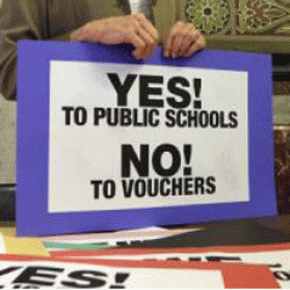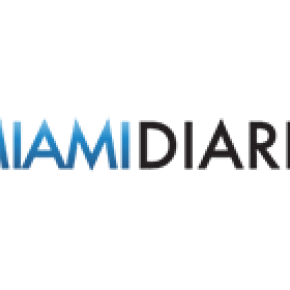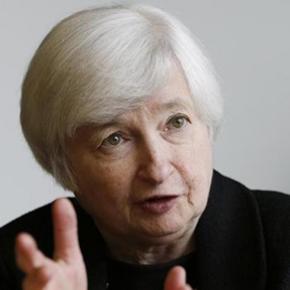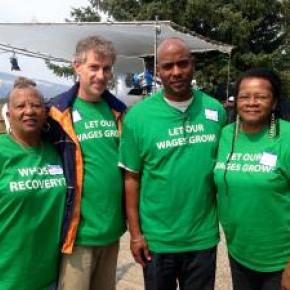Good jobs for everyone
The Hill - 05-06-2015 - The strain from Modesta...
The Hill - 05-06-2015 - The strain from Modesta Toribio’s retail job weighed down her life. Despite working full-time as a cashier in Brooklyn, Modesta struggled to pay for rent, food, or transportation. The bills added up quickly. Taking the day off to care for a sick child meant risking losing her job. Going to school at night was not an option, and she could not arrange for steady childcare because her schedule changed every week.
Modesta’s story is not unique. It is the story of countless strivers who work to sustain their families, but collide against structural barriers that keep them from making ends meet.
In this case, Modesta and her co-workers took action, organized and won concessions from their boss. It was not easy – their boss initially retaliated by cutting their hours. But, the workers gained momentum, and eventually they won better pay and better treatment.
For millions of others, though, they still do not have the dignity of a good job.
That is why the Center for Popular Democracy is proud to have launched an ambitious campaign to win good wages, benefits and opportunity for all workers with the Center for Community Change, Jobs with Justice and Working Families Organization. Named Putting Families First, the campaign will advance the audacious idea that every American should and can have access to a good job.
It’s an effort undertaken with a sense of urgency. We know that good jobs and access to them for all cannot be achieved without confronting the deep history and continuing reality of racism and sexism in America, particularly as they play out in the labor market.
As such, we propose five straightforward and commonsense tenets:
Guaranteeing good wages and benefits. Investing resources on a large scale to restart the economy in places of concentrated poverty. Taxing concentrated wealth. Valuing our families and the work of women who care for children and elders Building a green economy.What stands between us and an economy that works for everyone are rules that unfairly favor the greedy few because they are written by politicians beholden to wealthy special interests. But workers and families who are working together for change know well that rules written by the few can be re-written by the many.
Workers around the country are launching over 100 campaigns that embody an ambitious jobs agenda that includes everyone, elevating demands that speak to the reality of people throughout our country.
One example: making high quality child care available to all working parents, raising wages and benefits for the millions of women who work in early childhood education and care fields, changing the state and federal revenue models to make childcare more accessible, and providing financial support to unpaid caregivers.
Ensuring that all working families have access to quality, affordable childcare – and that the jobs in that industry provide living wages and good benefits – is crucial to women’s economic stability, especially women of color who are the vast majority of workers in this sector.
Winning these campaigns will make a huge difference for Modesta and her family, and for millions of families in this country who are struggling to make ends meet.
The reality is that there is bold action happening in every corner of this country. Whether we are talking about fast food workers striking across the country, or immigrant workers winning policies against wage theft, or entire communities organizing to win ballot initiatives to enact paid sick days and better wages.
The American public is thirsty for a visible effort to create real, good, dignified jobs for everyone.
We are supporting important local fights that will produce very real change in the lives of workers. And we are changing the broader frame in which those fights are waged. We are not tinkering at the margins. We have our eyes set on transforming the country through campaigns in 41 states – campaigns that grow every day.
We are setting out to challenge the orthodoxies of both parties to focus on the real problem: the need to create jobs and improve wages.
Like Modesta and her co-workers, we are coming together to stand up for ourselves, for our families, for our communities and for America. We have a vision of honoring the dignity of work, and the dignity of the people who work. We believe that we can do better, but that we will have to challenge those who are stealing our wages, limiting our ability to sustain our families and destroying our planet in order to do so.
Putting Families First will change the national conversation about work and about greed, starting where it matters most: in our states. It will enable us to live up to our collective responsibility to create the country that we want our children to live in.
Archila is co-executive director of the Center for Popular Democracy.
Source: The Hill
‘School Choice’ Mantra Masks the Harm of Siphoning Funds from Public Education
Ask an education “reform” proponent about any issue facing public education and the answer is always the same: “school choice.” Whether they’re championing charter schools, vouchers or Education...
Ask an education “reform” proponent about any issue facing public education and the answer is always the same: “school choice.” Whether they’re championing charter schools, vouchers or Education Savings Accounts (ESAs), advocates prefer to frame the debate around the right of parents to send their child to a better-performing school. This is merely a smokescreen to divert attention away from what school choice is really about: the transfer of public money to the private sector without accountability or transparency.
Many school choice campaigns are bankrolled by a faction of incredibly wealthy conservative donors and political groups, including the Koch Brothers and the American Legislative Exchange Council (better known as ALEC). Their agenda is clear: dismantle public education.
But it’s a safe bet you won’t hear their names during National School Choice Week (Jan 25-30). What you will hear is a lot of people parroting messages about “freedom,” “innovation,” “options,” even “civil rights” – buzzwords that underpin the campaigns to expand charter schools, vouchers and ESAs across the country. But the jargon masks the devastating impact these policies have had on public education, particularly on those students who are supposed to benefit the most.
Unaccountable Charter Schools: The Truth Hurts
Many people support the idea behind charter schools, but how many are aware of the mounting troubles the charter industry has experienced lately? Probably not enough. Proponents work very, very hard to maintain a facade of success and transparency in the face of evidence that many of these schools operate without any oversight, while wasting taxpayer money and fostering inequity and racial segregation.
Take the North Carolina State Board of Education, which just this month rejected the Department of Public Instruction’s annual report on charter schools as “too negative.” Dominated by school privatization stalwarts, the board is determined to prevent any meaningful oversight of the state’s charters and demanded revisions to the report before it could be submitted to the legislature.
North Carolina educator Stuart Egan took the board to task in an open letter to Lt. Governor and board member Dan Forrest: “Overall, charter schools seem to lack diversity and operate under a different set of rules according to the report you are trying to squelch. The fact is that many of the charter schools you have enabled are perpetuating segregation and are not accomplishing what you advertised they would do,” Egan wrote.
Given the magnitude of waste and fraud in the sector, it’s unsurprising why many charter operators are hiding from accountability and regulation. And according to a new study, the expansion of unregulated charter schools, particularly in urban communities, is beginning to resemble the effort a decade ago to pump up bad mortgages that eventually blew up the economy.
“Supporters of charter schools are using their popularity in Black, urban communities to push for states to remove their charter cap restrictions and to allow multiple authorizers,” Preston Green III of the University of Connecticut and co-author of “Are We Heading Toward a Charter School ‘Bubble’?: Lessons from the Subprime Mortgage Crisis” told EduShyster. “At the same time, private investors are lobbying states to change their rules to encourage charter school growth. The combination of multiple authorizers and a lack of oversight is creating an abundance of poor-performing schools in low-income communities.”
Vouchers: Who Is Really Benefitting?
According to the 2015 PDK/Gallup poll, a whopping 70 percent of Americans oppose school vouchers. They see it for what it is: a privatization scheme that subsidizes tuition for students in private schools. And perhaps they are aware that there is no conclusive evidence that vouchers improve student achievement. The public is also not fooled by the often-repeated falsehood that vouchers are primarily benefitting disadvantaged students.
In Scott Walker’s Wisconsin and Mike Pence’s Indiana, where vouchers have expanded dramatically, promises that the programs would serve low-income students in failing schools didn’t last. “That tale quickly and methodically changed,” said Teresa Meredith, president of the Indiana State Teachers Association. By 2015, only 2 percent of participants [in the voucher program] had attended an ‘F’ public school.
“The most expansive voucher program in America has become an entitlement program which, in large part, now benefits middle class families who always intended to send their children to private (mostly religious) schools and taxpayers are footing the growing bill,” Meredith said.
Education Savings Accounts (or Vouchers on Steroids)
In 2015, Nevada lawmakers were hoping to blaze a new trail for school choice with a new gambit, education savings accounts (ESA), which allow parents to claim more than $5,000 in state funds each year and use it for any qualified education expense. This includes religious-based private schools, but also a variety of other services, all with little or no oversight over student outcomes. In addition, states impose no quality controls on the textbooks, curriculum, tutoring, or supplemental materials that parents can purchase with ESA funds.
Education savings accounts exist in five states, but Nevada became the first to pass a bill that offered them to every public school student regardless of family income. Very few private schools in the state, however, have tuition low enough to be covered by the $5,100 or $5,700 provided annually by ESAs. Wealthier parents can supplement their own income to pay for the tuition, but for lower-income families private school will remain largely out-of-reach.
Earlier this month, a state judge slapped an injunction on the program. In his ruling, District Judge James Wilson said the law diverted public funds to pay for private school tuition and was therefore unconstitutional. The decision will be appealed because advocates have vested a lot in the scheme. ESAs are unquestionably the new school choice battleground and are being pushed in a growing number of states with proponents deploying the usual tropes about “freedom” and “flexibility” to mask their real impact: erosion of public school funding, fewer education resources, wider achievement gaps and increased segregation.
Real Innovation That Works
The good news is that a growing number of communities are finding solutions to struggling schools and achievement gaps that benefit all students, not just some. Educators and parents are working together to expand the community schools model, which is currently present in nearly 5,000 schools nationwide. When public schools extend services and programs beyond the school day, creating strong learning cultures and safe and supportive environments for both students and educators—in effect becoming community “hubs” – student outcomes improve. In 2015, Minnesota educators were instrumental in persuading the legislature to pass a bill creating a grant program for “Full-Service” Community Schools and other states may soon follow suit. To learn more about community schools, read “Investing in What Works” by the Southern Education Foundation and the Annenberg Institute for School Reform.
Source: NEA Today
The Government Should Guarantee Everyone a Good Job
Progressives have begun to dream more boldly. We have graduated from a public option to single payer. From lower sentences to eliminating cash bail. From motor-voter to automatic-voter...
Progressives have begun to dream more boldly. We have graduated from a public option to single payer. From lower sentences to eliminating cash bail. From motor-voter to automatic-voter registration. From affordable to free college. And from a $15 minimum wage to guaranteed good jobs for all.
Read the full article here.
The New York Times Comes Out Against Fed Interest Rate Hike
Progressive activists opposed to a Federal Reserve interest rate hike gained an influential new ally on Labor Day: The New York Times editorial board.
In a Monday editorial, entitled “You Deserve a Raise Today. Interest Rates Don’t,” the Times argued that if the Federal Reserve raises interest rates in the near term, it could slow job creation at a time when there are still too few jobs to generate substantial wage growth.
“Wage stagnation is a clear sign that the economy is not at full employment, which means it needs loose monetary policy, not tightening,” the Times wrote.
The Times called the Fed a “crucial player” in efforts to undo the decades-long trend of worker wages not growing in sync with the broader economy. The paper noted that from 1973 to 2014, median worker pay rose 7.8 percent while overall productivity increased by 72 percent, a finding published Wednesday in a report from the liberal-leaning Economic Policy Institute.
An interest rate hike would exacerbate, rather than reverse, this trend by slowing wage growth, the Times editorial suggested. The paper also said that an interest rate hike would send “the wrong signal of economic health,” undermining efforts by advocacy groups to raise workers’ wages through measures like increasing the minimum wage.
It is unclear what impact the Times’ editorial will have on the Fed’s decision-making, but it is a high-profile boost for progressive activists and economists, who have long argued that a Fed interest rate hike should be tied to wage growth that is about twice as high as it is currently.
These activists, led by the Center for Popular Democracy's Fed Up campaign, note that even as the official unemployment rate declined to 5.1 percent in August -- its lowest level since April 2008 -- wages have grown 2.2 percent in the past 12 months, only marginally outpacing increases in living costs. Since wages rise when demand for workers is high enough that businesses must compete for labor, many economists attribute ongoing sluggish wage growth to the number of people who are underemployed or have given up looking for work -- figures masked by the low official jobless rate.
The Fed Up campaign sent a memo to newspaper editorial boards across the country on Sept. 1, asking them to oppose an interest rate hike in 2015. The memo, a copy of which was obtained by The Huffington Post, employs arguments that resemble those used by The New York Times. The memo warned that an interest rate hike in 2015 would "leave millions in considerable andunnecessary economic distress and would exacerbate troubling longer-term trends in wages and incomes for the vast majority of American workers and their families."
Fed Up campaign director Ady Barkan celebrated the editorial, but stopped short of claiming credit for it.
"The New York Times Editorial Board is right," Barkan said in a statement. "Workers do deserve a raise! The data is crystal clear – stagnant wages and the lack of inflation mean that the Fed shouldn’t raise rates anytime soon. The Fed Up campaign is of course glad that the Times and other leading voices are speaking up about this issue."
Fed officials have signaled for months that they plan to raise the current near-zero interest rates before the year’s end, but William Dudley, president of the Federal Reserve Bank of New York, recently indicated that a September increase may be too soon in light of market fluctuations. The Federal Open Market Committee, the central bank body charged with adjusting key interest rates, will report on whether it plans to raise rates on September 17.
Supporters of an interest rate hike argue that it is necessary to head off excessive price inflation, which, along with maintaining full employment, is part of the Fed’s dual mandate.
Source: Huffington Post
Why Dianne Feinstein’s shutdown vote helps her re-election
Feinstein’s stand has earned her the approval, if not full-fledged embrace, of activists.
“She came right on the Dream Act and that’s really important,” said Center for Popular Democracy’s...
Feinstein’s stand has earned her the approval, if not full-fledged embrace, of activists.
“She came right on the Dream Act and that’s really important,” said Center for Popular Democracy’s Ady Barkan, who was among the activists leading a Jan. 3 rally at Feinstein’s Los Angeles office to press her on the issue.
Read the full article here.
Escuelas Chárter: Encuesta Cuestiona su Función y Pone la Lupa en sus Finanzas
Miami Diario - March 4, 2015 by Donatella Ungredda - Existe una preocupación creciente entre padres, representantes, maestros y contribuyentes a nivel regional y nacional con relación al...
Miami Diario - March 4, 2015 by Donatella Ungredda - Existe una preocupación creciente entre padres, representantes, maestros y contribuyentes a nivel regional y nacional con relación al rendimiento y cumplimiento de los objetivos educativos establecidos para las escuelas chárter. Las escuelas chárter son una forma más libre de educación pública o privada. Usualmente son fundadas por padres o maestros, manejadas por organizaciones con y sin fines de lucro; funcionan independientemente del sistema de educación pública y hacen hincapié en métodos y aéreas educativas más específicas. Normalmente atienden a un universo mucho más variado de alumnos y deben cubrir los requerimientos de educación especial de los mismos. El tamaño de las clases es más pequeño y en general se espera que tengan un nivel de rendimiento superior al promedio ya que, en teoría, al ser más libres de ensayar nuevas metodologías los alumnos encuentran más oportunidades para explotar sus capacidades. Estas instituciones conviven con las escuelas públicas que están sometidas a los estándares y regulaciones del Departamento de Educación y se mantienen con fondos públicos así como recolección de fondos privados. El crecimiento del número de escuelas chárter a nivel nacional se ha duplicado tres veces desde su implementación en el año 2000, según Donald Cohen, Director Ejecutivo de la organización no gubernamental In The Public Interest (ITPI). Cohen, junto a Kyle Serrette del Centro para la Democracia Popular (Center for Popular Democracy, CPD), revelaron los resultados de una reciente encuesta realizada entre un universo de 1000 votantes: la gran mayoría apoya la existencia de las escuelas chárter, pero asimismo exige una más exhaustiva supervisión del funcionamiento de estas instituciones, así como la realización de auditorías en sus finanzas, dados los pobres resultados académicos y la falta de transparencia en su administración. "Las escuelas chárter han estado presentes desde hace 20 años, y su funcionamiento se implementó para servir de ejemplo, marco referencial para la reforma del sistema educativo estadounidense. Nuestras investigaciones nos han revelado que 75% de las escuelas chárter han tenido un rendimiento igual o peor que las escuelas públicas para las cuales se supone debían servir como modelo de reforma. Este es un síntoma de falta de supervisión de parte de los responsables", afirmó Serrette "Lo que estamos tratando de lograr es poner un alto al crecimiento momentáneamente y asegurarnos que estamos obteniendo unos resultados educativos idóneos. Recordemos que estas escuelas se financian con fondos públicos y tomando en cuenta las dificultades que enfrenta la nación, debemos hacer una pausa y asegurarnos que tenemos una serie de medidas legales robustas para la protección de los alumnos, maestros y contribuyentes", agregó Cohen. ITPI y CPD consultaron a los encuestados acerca de una serie de 11 propuestas para la mejor supervisión de las escuelas chárter y su administración y en base a los resultados obtenidos dieron a conocer su Agenda de Responsabilidad de las Escuelas Chárter. Las 11 propuestas son abarcadas por 4 puntos principales: · Transparencia y responsabilidad, · Protección a las escuelas del vecindario, · Protección de los fondos aportados por los contribuyentes, · Educación de alta calidad para cada alumno.
Source
Toys 'R' Us owners will hand out $20 million severance to employees
The fund was set up following negotiations between the private equity firms and various public interest groups that organized the employees, including Organization United for Respect, Private...
The fund was set up following negotiations between the private equity firms and various public interest groups that organized the employees, including Organization United for Respect, Private Equity Stakeholder Project and Center for Popular Democracy. "This Fund begins to ensure the hard-working people who spent their lives building Toys 'R' Us and making children happy are not left out in the cold," said Marilyn Muniz, a New York-based Toys "R" employee for nearly 20 years.
Read the full article here.
Yellen Meets Activists on Economy
McClatchy Washington Bureau - November 14, 2014 - Federal Reserve Chair Janet Yellen met Friday with leaders of groups that want a voice in the selection of future presidents at the Fed’s 12...
McClatchy Washington Bureau - November 14, 2014 - Federal Reserve Chair Janet Yellen met Friday with leaders of groups that want a voice in the selection of future presidents at the Fed’s 12 district banks.
“The focus was making sure that working families’ voices were heard,” Connie Paredes of Dallas, who represented the Texas Organizing Project, told McClatchy after meeting more than an hour with Yellen.
Paredes was one of 30 activists from the Center for Popular Democracy, a nationwide network of liberal and faith-based organizations who want more Fed attention on returning the nation to full employment, and for a more public process of selecting Fed presidents.
Unlike most central banks, the Fed has a dual mission. It must guarantee price stability, and it does that with the goal of keeping inflation in a range between 1 percent and 2 percent. But it also has the mission of promoting full employment, and that’s the string activists pulled on Friday.
“The Federal Reserve should publicly commit to building an economy with genuine full employment … promising to keep interest rates low until the economy has reached full speed and is producing millions of new jobs and higher wages for workers across the economic spectrum,” said The National Campaign for a Strong Economy, another group that met with Yellen and issued a statement afterwards.
A pressing concern for the activists was creating a mechanism by which ordinary people can have some input in the selection of presidents at the Fed’s 12 district banks. The presidents of the Philadelphia and Dallas district banks, Charles Plosser and Richard Fisher, have announced their retirement next year.
Traditionally, Fed presidents are appointed by the board of directors of each of the 12 banks, with the approval of Fed governors in Washington. The terms are for five years, and they can be reappointed. Critics of the Fed argue that Wall Street and Corporate America get unusual sway because they make up the boards of directors at the Fed banks, and there hasn’t historically been input from the public.
“We need a (Dallas) Fed president that is very aware of the community that he or she represents. Not just the corporate banking community but the entire community,” said Paredes, who applauded Philadelphia’s creation of a feedback process but still wanted more public participation in the Fed’s selection process.
The Fed had no immediate comment on Friday’s meetings.
Source
Read more here: http://www.mcclatchydc.com/2014/11/14/246944_yellen-meets-activists-on-e...Fed Up Coalition comes to Jackson to join the conversation on Economic Policy
People in green shirts stating “Let Our Wages Grow” and “Who’s Recovery?” are all over the main lobby and outdoor areas of the lodge.
As officials meet for the Economic Policy Symposium,...
People in green shirts stating “Let Our Wages Grow” and “Who’s Recovery?” are all over the main lobby and outdoor areas of the lodge.
As officials meet for the Economic Policy Symposium, the Fed Up Coalition consisting of workers, economists, and allies are holding a conference simultaneously to discuss ways to foster full employment, higher wages and racial equality.
Ed Donaldson, who is with the San Francisco Alliance of Californians for Community Emplowerment is here to join the conversation on interest rates, unemployment and how the decisions of the Federal Reserve impact Americans.
“We are here exercising our democracy,” said Donaldson. “Monetary policy and the activities of the Federal Reserve are so very important.”
Between 75-100 representatives for the Fed Up Coalition from all over U.S. are at the Jackson Lake Lodge to voice their opinion.
“We have people here who represent every Federal Reserve district across the country. Many have met with Federal Reserve presidents in their area, which has been a very interesting dialog,” he added.
According to Donaldson, instead of looking at abstract data, it is important to have people who can tell you first hand how the economy is impacting them.
“I don’t think numbers tell the whole story about what’s going on. We have a high number of long term unemployed people and a high rate of underemployment. The Federal Reserve assisted Wall Street in getting them out of trouble and we think it’s only democratic that they begin to look at main street and look at ways they can help,” he added.
The Fed Up Coalition’s voice is beginning to be heard. Donaldson mentioned that the Federal Reserve is creating a Community Advisory Counsel, where they will select 15 people to help get insight from the ground.
“I am happy to be here. I think in many ways this is historic,” said Donaldson. “We sort of butted into the conversation, but I think it is far too important of an issue to let this conversation take place and not ask questions.”
The 2015 Economic Symposium’s central theme is “Inflation Dynamics and Monetary Policy,” and takes place August 27-29 at the Jackson Lake Lodge in Grand Teton National Park.
Source: Buckrail
The latest fight for employee rights: work schedule predictability

The latest fight for employee rights: work schedule predictability
Efforts to boost the minimum wage have gotten a lot of attention lately and proponents have scored some major victories. But workers rights advocates are now asking: What good is a wage boost if...
Efforts to boost the minimum wage have gotten a lot of attention lately and proponents have scored some major victories. But workers rights advocates are now asking: What good is a wage boost if workers don’t know how many hours they’re working every week?
Read the full article here.













2 months ago
2 months ago